
Artificial intelligence has been a hot button topic for countless debates over the past year, especially on college campuses. As various AI tools strive to redefine the learning experience, platforms like ChatGPT have piqued the interest of students, wielding both promise and skepticism.
A recent survey from BestColleges Data Center reveals that more than half of college students are in full support of AI, and have used AI tools to help them complete coursework. The other half, however, stand firm in their beliefs that the use of these tools in classrooms constitutes plagiarism.
However students and faculty feel about AI, one thing is for sure: it’s not going away anytime soon. Therefore, many institutions are following the old phrase, “If you can’t beat ‘em, join ‘em,” and directing their energy toward workshops, studies, classes and policies all geared towards helping people understand AI.
We’ve rounded up some news stories that shine a light on how campus communities are responding to advancements in AI – and they’re certainly being creative. While one college in Michigan enrolled two AI bots as students, two schools in Massachusetts teamed up to form a Women in AI club. Read more to see how AI is becoming a fixture of university life.
Who’s Joining Forces…
- Women at MIT and Harvard. The two Massachusetts schools have teamed up to launch a new club, Women in AI. The purpose of the club is to increase accessibility, support and education for women from both colleges who are studying or interested in AI and machine learning. The group hosts a range of activities including Q&A panels with AI experts, workshops and book clubs. Members have also created their own podcast that discusses how AI is used in daily life. The club, sponsored by AI companies like IMC and Citadel, offers college women opportunities to network and collaborate on projects related to AI.
AI’s Biggest Red Flags
- Plagiarism. At Memorial University in Canada, the student union has reported a spike in accusations of plagiarism as a result of wider access to AI technology. Tools such as ChatGPT and Grammarly have opened up a debate over what constitutes plagiarism, and how faculty should respond when students use these tools. Josh Lepawsky, president of the faculty association, told CBC News he doesn’t believe students are using AI as a replacement for doing their work. However, MacKenzie Broders, executive director of advocacy with the student union, said that even the most minor use of AI “constitutes academic misconduct.”
- Bias. AI tools like language models are fairly new, and they can often be biased due to the inherent biases present in the training data they learn from. To counteract this bias, Morgan State University in Maryland opened a center where faculty and students can conduct research on how AI can be used to help people from minority groups. Researchers are using AI tools for all kinds of purposes, from diagnosing autism to creating wheelchairs. They are also working on ways to reprogram AI applications to take race and gender disparities into account. The center aims to use “thought leadership in the application of fair and unbiased technology,” as per its mission statement.
A New Record for “Words Read per Minute”

- Thanks to this new tool. Researchers at the University of Colorado Boulder have developed an AI program capable of analyzing college admissions essays. They tested it out using 300,000 essays written by past applicants about extracurricular activities and work experiences, with a goal of identifying key traits such as motivation and willingness to help others. The feedback from AI readers largely aligned with the feedback from human readers, exhibiting similar judgment. While the study raised concerns about algorithmic bias targeting applicants from certain racial or socioeconomic backgrounds, researchers claim they created the tool with this concern in mind, and have not faced problems yet.
Let’s Make the New Students Feel Welcome
- They’re AI bots. Named Ann and Fry, these two AI-generated virtual students will be enrolled as freshmen this semester at Ferris State University in Michigan, where they will actively participate in hybrid classes. Students and professors are encouraged to interact with them just as they would interact with fellow students. Faculty members have even crafted backstories for Ann and Fry, mirroring real student experiences, which will play a role in guiding the virtual students through tasks like declaring a major. The goal of this experiment is to help faculty get a better understanding of how AI learning tools can be implemented in classrooms.
Who’s Just Trying to Figure It Out

- Faculty. Instead of resisting AI, professors at Ole Miss have decided to work with it. The Mississippi university is now hosting short training programs for faculty members to learn strategies for incorporating AI into their curriculums. It began last June with the two-day AI Summer Institute for Teachers of Writing, and is picking up again this month with the three-day AI Winter Institute for Teachers. The program is divided into three sections: AI Literacy, AI Assistance and AI Frontiers. Each attendee is given a $500 stipend, with additional funding available for those interested in pursuing projects or policies pertaining to generative AI in education.
- Students. At Northeastern University, students are being given the opportunity to learn about how AI can be used in business through the Institute for Experiential AI. According to the executive director, Usama Fayyad, experiential AI means “having AI with a human in the loop.” In other words, AI is not used as a replacement for humans, but as a tool to help humans achieve more. With over 80 core faculty members, the center has established itself as one of the leading AI institutes for students. Its AI Solutions Hub offers students the chance to collaborate with industry leaders and learn about how AI can be applied in the business world.
What College Women Have to Say About All of This
- In her piece for The Reflector, University of Indianapolis student Olivia Pastrick tells readers why she believes AI has no place in education – at least not until there are well-defined policies.
- In an opinion piece for The Daily Illini, columnist and University of Illinois student Natalia Debrowska explains why she thinks universities need to educate students on AI.
- In The Daily Texan, UT Austin student Charlotte Fades argues that AI can be helpful in leveling the playing field for students with learning disabilities like dyslexia.



